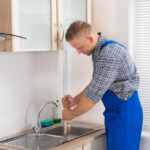In part one of this two-part blog, we went over some of the basics when it comes to the causes of drain clogs and your initial responses to them. Drain clogs are some of the most common plumbing issues out there, and while they may just be inconveniences in some cases, in others they can create significant damage, cost and hassle.
At Action Plumbing, Heating, Air & Electric, we can help with any and all drain cleaning needs. In today’s part two, we’ll go over a few of the options at your disposal for clearing drain clogs that do crop up – we’ll start with minor clogs that can usually be resolved relatively easily, and then move to heavier clogs that might require a bit more effort.
Options for Clearing Minor Clogs
If you notice certain sink drains that are a bit slower than usual to clear out, or even if you’re just a diligent homeowner looking to keep drains clear with a quarterly cleaning, you have a couple simple options that require nothing but home materials at your disposal:
- Basic water flush: All you need is a large pot from your kitchen, in which you should pour as much hot water as you can. Be sure to keep water hot but not boiling, as boiling water may actually cause its own set of drain issues. Pour this down the drain in question, and then follow it with a similar amount of cool water – the hot water will loosen and melt many blockages, while the cool water will flush them down.
- Baking soda/vinegar combo: In other situations, you can try pouring a half-cup of baking soda down the drain, followed by a half-cup of vinegar. After doing so, plug up the drain in question and leave it overnight. In the morning, flush the drain down with hot water.
Clearing Heavier Clogs
In other cases, your drain might be completely or more heavily clogged to the point where the above solutions do not work. In these cases, you have a couple other options you can try before you call in our pros:
- Plunger: The type of plunger you use depends on the location of the clog. Flat drain surfaces require cup plungers, while curved surfaces like toilet bowls require flange plungers with an additional suction device on them. Place the plunger over the drain and plunge up and down – in most cases, you’ll notice the clog loosening as plunging becomes easier.
- Snake or auger: These are tools that actually reach down into the drain to help break up clogs, usually made of either wire, plastic or metal. You feed them into the drain and then turn a handle that spins the head, picking up clogs and allowing you to pull them out.
If the above methods aren’t effective or you aren’t comfortable with any of them, our plumbers are happy to help. To learn about our drain cleaning or any of our other plumbing or HVAC services, speak to the staff at Action Plumbing, Heating, Air & Electric today.


